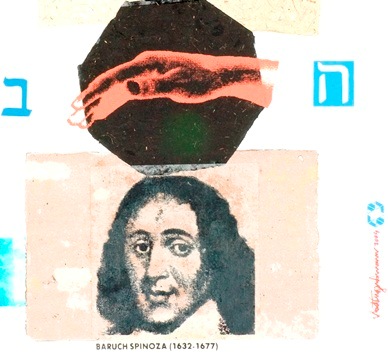Representations of the Jewish memory and the Jewish exile in the Bernard Malamud's novel The Fixer and in some paintings by Marc Chagal
DOI:
https://doi.org/10.17851/1982-3053.5.9.39-49Keywords:
Memory, Exile, Malamud, ChagallAbstract
This paper aims to make an intersemiotic analysis about the Jewish memory and exile in the novel The fixer, by Jewish American writer Bernard Malamud (1914-1986), published in 1966, and in some pictures of the Jewish Russian painter Marc Chagall (1887-1985), for example: Exodus (from 1952-1956), The White Crucifixion (from 1938), I and my Village (from 1911). In spite of they had been raised up in distinct Jewish generations, Malamud (son of Jewish Russian immigrants that went to the United States) and Chagall (immigrated to France), both take as theme the home-place from where originated their families, the shtetl (small village, in Yiddish). The shtetlekh were small cities demarcated in Poland and Russian during the ninth and twenty centuries; centers of the Jewish religious and cultural life. For many immigrated European Jews and their descendants, the shtetl became the nostalgic, primordial and mythical place, in spite of the destruction occasioned by the pogroms and the Holocaust. For this reason, art’s men as Malamud and Chagall recreated the shtetl’s life in their works, having recourse to the zekher, the collective and the individual memory of the Jewish people, whose transmission occurs by means of the ritual and the narrative. Therefore, the memory recreates time and space, transgressing chronologies; this mnemonic phenomenon is showed in the Malamudian novel The fixer and the Chagallian picture, because both artists searched the oniric universe and the unconscious, Surrealism’s elements. Furthermore, Malamud and Chagall take as theme the exile suffered by the Jewish people deconstructing the use of the crucifixion of Christ as anti-Semitic pretext. Malamud makes it through the character Yakov Bok, anti-hero that lives individually a self-exile under the implications of the historical and collective exile of the Jewish people. Likewise, Chagall makes it, according to his vision, by means of the recreation the Ahasuerus legend, the wandering Jew
Downloads
References
BEREZIN, Rifka. Caminhos do povo judeu. São Paulo: Federação Israelita do Estado de São Paulo, 1977. v. 4.
CEDILLO, Adolfo Gómez. Marc Chagall. Trad. Berta Rodrigues Silveira. Rio de Janeiro: Civilização Brasileira, 1997.
CHEVALIER, Jean; GHEERBRANT, Alain. Dicionário de símbolos. Trad. Vera da Costa e Silva. 23 ed. Rio de Janeiro: José Olympio, 2009.
GOTLIEB, Roger S. This sacred earth: Religion, Nature, Environment. New York: Taylor & Francis Books, 2004.
GRYLAK, Moshe. Reflexões sobre a Torá. Trad.Marcelo Firer. São Paulo: Sêfer, 1998.
GUINSBURG, Jacó. Aventuras de uma língua errante: ensaios de literatura e teatro ídiche. São Paulo: Perspectiva, 1996.
HALBWACHS, Maurice. A memória coletiva. Trad. Beatriz Sidou. São Paulo: Centauro, 2006.
HUA, Ann. Diaspora and Cultural Memory, In: AGNEW, Vijai (Ed.). Diaspora, Memory, and Identity: A Search for Home. Toronto: University of Toronto Press, 2005.
IGEL, Regina. Emigrantes judeus, escritores brasileiros. São Paulo: Perspectiva, 1997.
JACOBS, Joseph. Wandering Jew, In: JEWISH ENCYCLOPEDIA, 2002. Disponível em: Acesso em: 26 abr. 2010.
MALAMUD, Bernard. O faz-tudo. Trad. Maria Alice Máximo. Rio de Janeiro: Record, 2006.
MALAMUD, Bernard. O barril mágico. Trad. Maria Alice Máximo. Rio de Janeiro: Record, 2007.
MALAMUD, Bernard. The art of fiction. In: Paris Review Foundation. Paris. n. 52, p. 1-25, 2005.
MALAMUD, Bernard. Conversations with Bernard Malamud. Edited by Lawrence Lasher. Mississipi: University Press of Mississippi, 1991.
PANOFSKY, Erwin. Meaning in the Visual Arts. New York: Doubleday, 1955.
SAID, Edward. Reflexões sobre o exílio e outros ensaios. Trad. Pedro Maia Soares. São Paulo: Companhia das Letras, 2003.
SALZBERG, Joel. The Loathly Landlady: Chagallian Unions and Malamudian Parody: “The Girl of My Dreams” Revisited. In: Studies In Short Fiction, v. 30, n. 4, Sep. 22, 1993, p. 543-554.
UNTERMAN, Alan. Dicionário judaico de lendas e tradições. Trad. Paulo Geiger. Rio de Janeiro: Jorge Zahar, 1992.
YERUSHALMI, Yosef Hayim. Zakhor: Jewish History and Jewish Memory. Washington: University of Washington Press, 1996.
ZOLLMAN, Joellyin. The shtetl in Jewish history and memory. Disponível em: http://www.myjewishlearning.com/history/Modern_History/1700-1914/Shtetls.shtml. Acesso em: 08 mar. 2010.
WALTHER, Ingo F.; METZGER, Rainer. Marc Chagall (1887-1985): poesia em quadros. Trad. Lisette Queiróz Werner. Rio de Janeiro: Paisagem Distribuidora, 2006.
WIESEL, Elie. Por que escrevo? In: VIEIRA, Nelson H. (Org.). Construindo a imagem do judeu. Trad. Alexandre Lissovsky, Elisabeth Lissovsky. Rio de Janeiro: Imago, 1994.
Downloads
Published
How to Cite
Issue
Section
License
Os direitos autorais pertencem exclusivamente aos autores. Os direitos de licenciamento utilizados pelo periódico é a licença Creative Commons Attribution 4.0 (CC BY 4.0): são permitidos o compartilhamento (cópia e distribuição do material em qualquer meio ou formato) e adaptação (remix, transformação e criação de material a partir do conteúdo assim licenciado para quaisquer fins, inclusive comerciais.






